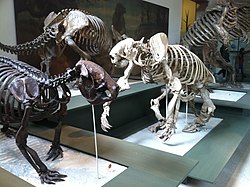Ground sloth
| Ground sloths Temporal range: 35–0.005 Ma Late Eocene – Holocene |
|
|---|---|
 |
|
| Fossils of different ground sloths at the American Museum of Natural History in New York | |
| Scientific classification | |
| Kingdom: | Animalia |
| Phylum: | Chordata |
| Class: | Mammalia |
| Subclass: | Theria |
| Infraclass: | Eutheria |
| Superorder: | Xenarthra |
| Order: | Pilosa |
| Suborder: | Folivora (partim) |
| Families | |
|
|
Ground sloths are a diverse group of extinct sloths, in the mammalian superorder Xenarthra. The term "ground sloth" is used as a reference for all extinct sloths because of the large size of the earliest forms discovered, as opposed to the extant "tree sloths." However, this is a historical convention and should not imply that all extinct sloths were strictly terrestrial in nature. Their most recent survivors lived in the Antilles, where it has been proposed they may have survived until 1550 BCE; however, radiocarbon dating suggests an age of between 2819 and 2660 BCE for the last known occurrence of Megalocnus in Cuba. Ground sloths had been extinct on the mainland of North and South America for 10,000 years or more. Their later survival in the Caribbean correlates with the later colonization of this area by humans. Some insular sloth populations persisted 5,000–6,000 years longer than their continental mainland relatives, in congruence with the global pattern of late Quaternary large vertebrate extinction due to human dispersal.
The bulk of ground sloth evolution took place during the mid to late Tertiary of South America while the continent was isolated. At their earliest appearance in the fossil record, the ground sloths were already distinct at the family level. The presence of intervening islands between the American continents in the Miocene allowed a dispersal of forms into North America. A number of mid- to small-sized forms are believed to have previously dispersed to the Antilles islands either by making short swims or using land bridges. Ground sloths were a hardy group as evidenced by their diverse numbers and dispersals into remote areas given the finding of their remains in Patagonia (Cueva del Milodón) and parts of Alaska.
...
Wikipedia
